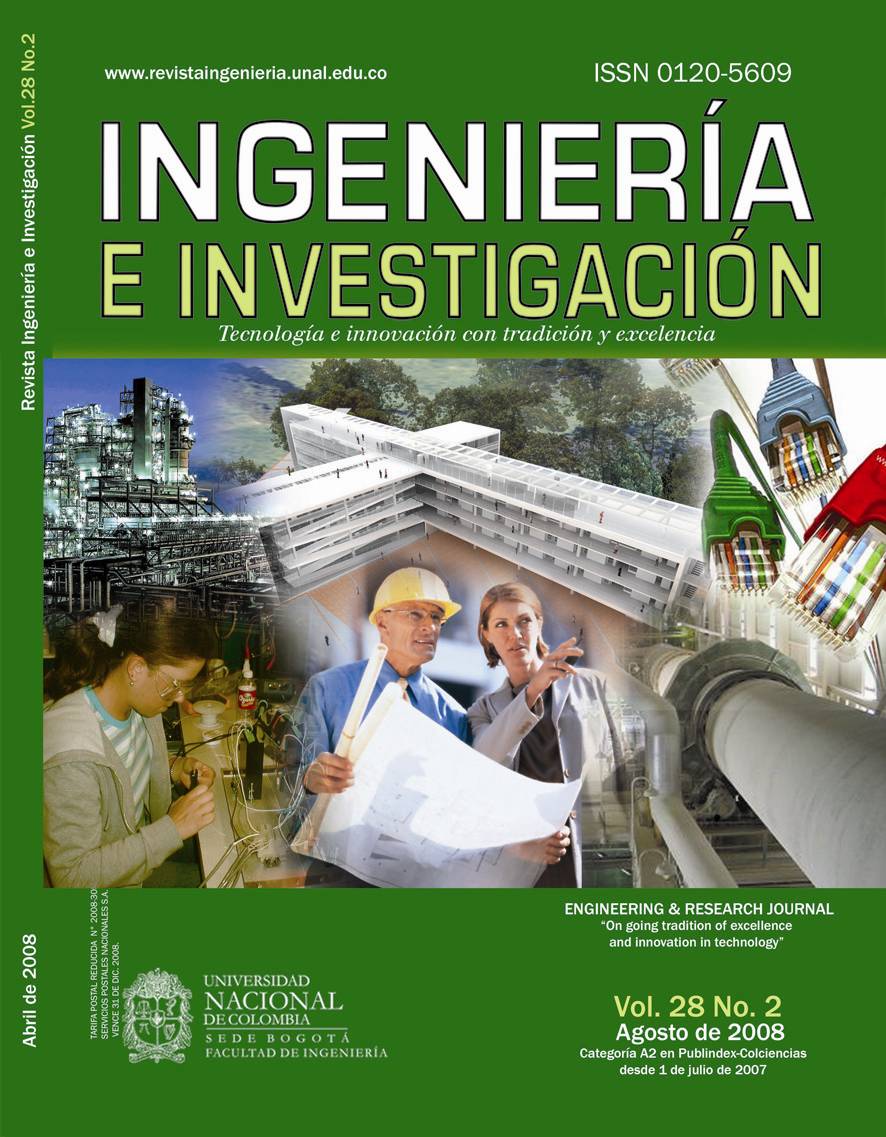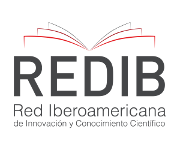Hydrodynamic ecohydraulic habitat assessment aimed at conserving and restoring fluvial hydrosystems
Evaluación hidrodinámica del hábitat ecohidráulico dirigida a la conservación y restauración de hidrosistemas fluviales
DOI:
https://doi.org/10.15446/ing.investig.v28n2.14899Keywords:
ecohydraulics, aquatic habitat, 2D/3D model, hydrodynamics (en)ecohidráulica, hábitat acuático, modelos 2D/3D, hidrodinámica (es)
Downloads
Fluvial conservation and restoration measures’ efficiency was evaluated in terms of ecological state enhancement, comparing future scenarios with historical or altered conditions. Ecohydraulics provides valuable scientific tools for the environmental diagnosis of lotic ecosystems, evaluating the combined effect of flow regime and channel structure on habitat quality for aquatic biota. This paper adopts an analytic-synthetic approach to the interdisciplinary challenge of fluvial ecohydraulics for computational fluid dynamics (CFD) within the framework of ecosystem water management. The procedure for multidimensional (2D/3D) evaluation of the physical aquatic habitat is described as well as its predictive ability and main applications. The 2D depth-averaged scheme is highlighted whose velocity simulation error (being normally lower than 10%) overcomes classic one-dimensional (1D) simplifications. The basic aspects of biological habitat modelling, abiotic variables and biological preference are summarised. Combining eco logical criteria with hydrodynamic flow patterns is illustrated for producing discrete habitat fields which were then spatially and temporarily integrated in ecohydraulic analysis.
La eficacia de las medidas de conservación y restauración fluvial es evaluada en términos de la mejora del estado ecológico, comparando los escenarios futuros con las condiciones históricas o alteradas. La ecohidráulica ofrece herramientas científicas valiosas para diagnosticar ambientalmente los ecosistemas lóticos, evaluando el efecto combinado del régimen de caudales y la estructura del cauce en la calidad del hábitat acuático. Este trabajo aborda de modo analítico-sintético el desafío interdisciplinar que supone la ecohidráulica fluvial para la dinámica computacional de fluidos (DCF), en el contexto de la gestión hídrica ecosistémica. Se describe el procedimiento de evaluación multidimensional (2D/3D) del hábitat acuático, su capacidad predictiva y las aplicaciones principales. El modelamiento hidrodinámico es revisado en cuanto al esquema de caracterización fluvial y las formulaciones físicas. Se destaca el esquema 2D integrado en profundidad (depth-averaged), cuyo error predictivo de velocidad, normalmente inferior al 10%, supera las simplificaciones clásicas unidimensionales (1D). Se resumen los aspectos básicos de los modelos biológicos de hábitat, como son las variables abióticas y la preferencia biológica. Finalmente, se ilustra la combinación de los criterios ecológicos con los patrones hidrodinámicos de flujo, para generar los campos de hábitat discretizados que se integran espacial y temporalmente en los análisis ecohidráulicos.
References
Allan, J. D., Stream Ecology Structure and function of running waters., Chapman & Hall, 1995.
Baker, T. J., Three-dimensional mesh generation by the triangulation of arbitrary point sets., AIAA Paper 87-1124- CP, 1987, pp. 255-271. DOI: https://doi.org/10.2514/6.1987-1124
Bechara, J., Morin, J., Boudreau, P., Évolution récente de l´habitat du doré jaune, de la perchaude, du gran brochet et de l´achigan à petite bouche au lac Saint-François, fleuve Saint-Laurent., R640, INRS-Eau, Terre & Environnement, 2003. 74 pp.
Bechara, J. A., Alabarcez, M. N., Ruiz Díaz, F. J., Informe final de la primera etapa del proyecto GEF-PNUD ARG02/G35. Instituto de Ictiología del Nordeste., Facultad de Ciencias Veterinarias, Universidad Nacional del Nordeste, Corrientes, Argentina, 2005.
Boudreau, P., Bourgeois, G., Leclerc, M., Belzile, L., Two dimensional habitat model validation based on spatial fish distribution: Application to juvenile atlantic salmon of Moisiei River (Québec, Canada)., Proceedings of the 2nd international symposium on habitat hydraulics, INRS-Eau, Quebec, Canadá, 1996, pp. B365-B380
Bovee, K. D., The incremental method for assessing habitat potential for cool water species., with management implications. American Fisheries Society, Special Publication 11, 1978, pp.340-346.
Bovee, K. D., A guide to stream habitat analysis using the instream flow incremental methodology., Instream Flow Information Paper No. 12, U.S. Fish and Wildlife Service, Fort Collins, Colorado, 1982.
Bovee, K. D., Development and Evaluation of Habitat Suitability Criteria for Use in the Instream Flow Incremental Methodology. Instream Flow Paper No. 21, Fort Collins, Colorado, EEUU, 1986.
CER (Center for Ecohydraulic Research)., University of Idaho, EEUU. www.uidaho.edu/ecohydraulics/.
Coysh, J., Marshall, J., McGregor, G., Marshall, C., An ecohydraulic approach to flow regime assessment., Proc.VI International Symposium on Ecohydraulics, Christchurch, New Zealand, 2007.
Davis-Colley, R. J., Vant, W. N., Smith, R. G., Colour and clarity of natural waters: science and management of optical water quality., Ellis Horwood, New York, 1993.
De Nicola, D. M., McIntire, C. D., Effects of substrate relief on the distribution of periphytn in laboratory streams., Journal of Phycology, 26, 1990, pp. 624-633. DOI: https://doi.org/10.1111/j.0022-3646.1990.00624.x
Diez-Hernández, J. M., Técnicas avanzadas para la evaluación de caudales ecológicos en la ordenación sostenible de cuencas hidrográficas. Ing. Invesig., Vol. 26, No. 10, 2006a, pp. 61-70.
Diez-Hernández, J. M., Modelación Fluvial Multidimensional (1D-2D) Aplicada al Cálculo de Caudales Ecológicos., Actas XVII Seminario Nacional de Hidráulica e Hidrología, 15-16/09/2006, Popayán, 2006b.
Diez-Hernández, J. M., Burbano Burbano, L., Revisión de los modelos eco-hidráulicos unidimensionales y bidimensionales en corrientes fluviales., Avances en Recursos Hidráulicos, 15, 2007, pp. 75-88.
Diez-Hernández, J. M., Ruiz Cobo, D. H., Determinación de caudales ambientales confiables en Colombia: el ejemplo del Río Palacé (Cauca)., Gestión y Ambiente, Vol. 10, No. 1, 2007, pp. 153-166.
Diplas, P., Shen, Y., Use of two- and three-dimensional hydraulic models for addressing ecological aspects of stream flows., Proc. Sixth International Symposium on Ecohydraulics, 18-23/02/2007, Christchurch, New Zealand, 2007.
Dudgeon, D., Arthington, A. H., Gessner, M. O., Freshwater biodiversity: importance, status, and conservation challenges., Biological Reviews, 81, 2006, pp.163-182. DOI: https://doi.org/10.1017/S1464793105006950
García de Jalón, D., Casado, C., Mayo, M., Villeta, C., Estimación de caudales ecológicos mínimos para el río Ojailén a su paso por Puertollano., INTECSA. 1989.
Goring, D. G., Biggs, B. J. F., The effect of velocity and turbulence on the growth of periphyton in a cobble-bed stream: The 5-stone experiment., Proceedings of the 2nd IAHR International Symposium on Habitat Hydraulics, 1996, pp. A239-A250.
Habersack, H. M., Hydraulic Simulation of Natural River Sections – Field study and numerical model verification., Proceedings of IAHR Congress, Graz, Alemania, 1999.
Hardy, T. B., Addley, R. C., Instream Flow Assessment Modelling: Combining Physical and Behavioural Based Approaches., Canadian Water Resources Journal, 28 (2), 2003, pp. 273-282. DOI: https://doi.org/10.4296/cwrj2802273
Hauer, D., Tritthart, M., Unfer, G., Schmutz, S., Habersack, H., The necessity of modeling the stability of spawning grounds between 1D, 2D and 3D numerical models., Proc. Sixth International Symposium on Ecohydraulics, 18- 23/02/2007, Christchurch, New Zealand, 2007.
Henriksen, J., James, A., Heasley, J., Kennen, J.G. y Niewsand, S. User's manual for the Hydroecological Integrity Assessment Process. USGS, File Report 2006- 1093, 2006.
James, C. S., Kleynhans, M. T., Birkhead, A.L., Predicting hydro-ecological impact in a seasonal floodplain., Proceedings 5th International Symposium on Ecohydraulics, Madrid, 2004, pp. 1373-1378.
James, C. S., Thoms, M. C., The Natural Flow Paradigm Revisited., Proc. Sixth International Symposium on Ecohydraulics, 18-23/02/2007, Christchurch, New Zealand, 2007.
Jorde, D., Scheneider, M., Peter, A., Zoellner, F., Fuzzy based models for the evaluation of fish habitat quality., Proceedings 2001 International Symposium on Environmental Hydraulics, 2001.
Jowett, I. G., River hydraulics and Instream habitat modeling for river biota., En: Waters of New Zealand, Moseley, M.P. (ed.), New Zealand Hydrological Society, 1992, pp. 249- 263
Katopodis, C., Case studies of instream flow modelling for fish habitat in Canadian Prairie Rivers., Special issue of the Canadian Water Resources Journal, Vol. 28, No. 2, 2003, pp. 199-216. DOI: https://doi.org/10.4296/cwrj2802199
Klonidis, A. T., Soulis, J. V., An implicit scheme for two dimensional free-surface flow calculation., Journal of Hydraulic Research, Vol. 39, No. 4, 2002, pp. 25-34. DOI: https://doi.org/10.1080/00221680109499843
Koboltschnig, G., Mader, H., Mayr, P., WG1a Raw Data Sub-group: Physical Habitat and instrumentation.,
European Aquatic Modelling Network (EAMN) COST Action 626, 2002.
Leclerc, M., Ecohydraulics, last frontier for fluvial hydraulics: research challenges and multidisciplinary perspectives., Proceedings of RiverFlow 2002 Conference, Louvain-la Neuve, Belgium, 2002.
Leclerc, M., Boudreault, P., Bechara, J., Corfa, G., Two dimensional hydrodynamic modeling: a neglected tool in the Instream Flow Incremental Methodology., Transactions American Fisheries Society, Vol. 124, No. 5, 1995, pp. 645-662. DOI: https://doi.org/10.1577/1548-8659(1995)124<0645:TDHMAN>2.3.CO;2
Leclerc, M. A., Bechara, J., State-of-the-art and perspectives of habitat modeling for determining conservation flows., Canadian Water Resources Journal, Vol. 28, No. 2, 2003, pp.135-172. DOI: https://doi.org/10.4296/cwrj2802135
McBride, G. G., Cooke, J. G., Cooper, A. B., Smith, C. M., Optimising the compensation flow requirements of a river impounded for water supply., En: Rivers for our Future, Department of Irrigation and Drainage, Kuala Lumpur, Malasya, 1993, pp. 4B/1/1-15. g.
Milhous, R. T., Relating Streamflows to the Health of an Aquatic Ecosystem., Proc. Sixth International Symposium on Ecohydraulics, 18-23/02/2007, Christchurch, New Zealand, 2007.
Muller, G. A., Marsh, P.C., Lost a desert river and its native fishes: a historical perspective of the lower Colorado River., USGS Information and Technology Report USGS/BRD/ITR-2002-0010, 2002.
Nature Conservancy., Indicators of Hydrologic Alteration., http://www.nature.org, 2007.
Olsen, N.R.B. Hydroinformatics, fluvial hydraulics and limnology. Norwegian University of Science and Technology. Trondheim, Noruega, 2002.
Panayiotis, D., Shen, Y., Use of two and three-dimensional hydraulic models for addressing ecological aspects of the stream flows., Proc. Sixth International Symposium on Ecohydraulics, 18-23/02/2007, Christchurch, New Zealand, 2007.
Parasiewicz, P., MesoHABSIM: A concept for application of instream flow models in river restoration planning., Fisheries, Vol. 26, No. 9, 2001, pp. 6-13. DOI: https://doi.org/10.1577/1548-8446(2001)026<0006:M>2.0.CO;2
Parra, O., Valdovinos, C., Habit, E., Determinación del caudal mínimo ecológico del proyecto hidroeléctrico Quilleco., Universidad de Concepción, Concepción, Chile, 2001.
Poff, N. L., Voelz, N. J., Ward, J. V., Algal colonisation under four experimentally-controlled current regimes., Canadian Journal of Fisheries and Aquatic Sciences, Vol. 46, 1990, pp.1805-1818.
Poff, N. L., Natural Flow Regime as paradigm for river restoration., Proccedings Fifth International Symposium on Ecohydraulics, 12-17/09/2004, Madrid, España, 2004.
Pollino, C. A., Woodberry, O., Nicholson, A., Korb, K., Hart, B. T., Parameterisation and evaluation of Bayesian network in risk assessment., Environmental Modelling and Software, 23, 2006, pp. 145-162.
Schneider, M., Jorde, K., Fuzzy-ruled based models for the evaluation of fish habitat quality and Instream flow assessment., Proceedings of the IFIM User´s Workshop, Fort Collins, Colorado, 1-5 Julio, 2003.
Secretan, Y., Leclerc, M. Duchesne, S., Heniche, M., Une méthodologie de modélisatio pour la simulation hydrodynamique bidimensionnelle., Revue des Sciences de l´eau, 14(2), 2001, pp. 187-212. DOI: https://doi.org/10.7202/705417ar
Shirvell, C. S., Pitfalls of physical habitat simulation in the Instream Flow Incremental Methodology., Technical Report of Fisheries and Aquatic Sciences 1460, 1986.
Steffler, P., Sandelin, J., Yang, Z., R2Mesh versión 2.03. University of Alberta, Alberta, Canadá, 2006.
Zalewski, M., Flood pulses and river ecosystem robustness., International Association of Hydrological Sciences (IAHS), Vol. 305, 2006, pp.143-154.
Zang, Y., Jia, Y., CCHE2D Mesh Generator Versión 2.6., National Center for Computational Hydroscience and Engineer, University of Mississippi, EEUU, 2005.
How to Cite
APA
ACM
ACS
ABNT
Chicago
Harvard
IEEE
MLA
Turabian
Vancouver
Download Citation
CrossRef Cited-by
1. N. Pasquale, P. Perona, A. Wombacher, P. Burlando. (2014). Hydrodynamic model calibration from pattern recognition of non-orthorectified terrestrial photographs. Computers & Geosciences, 62, p.160. https://doi.org/10.1016/j.cageo.2013.06.014.
2. Pavel Kovar, Frantisek Krovak, Vit Rous, Michal Bily, Miroslav Salek, Darina Vassova, Michaela Hrabalikova, Vaclav Tejnecky, Ondrej Drabek, Tereza Bazatova, Jitka Peskova. (2014). An appraisal of the effectiveness of nature‐close torrent control methods – Jindrichovicky Brook case study. Ecohydrology, 7(5), p.1281. https://doi.org/10.1002/eco.1453.
Dimensions
PlumX
Article abstract page views
Downloads
License
Copyright (c) 2008 Juan Manuel Diez Hernández

This work is licensed under a Creative Commons Attribution 4.0 International License.
The authors or holders of the copyright for each article hereby confer exclusive, limited and free authorization on the Universidad Nacional de Colombia's journal Ingeniería e Investigación concerning the aforementioned article which, once it has been evaluated and approved, will be submitted for publication, in line with the following items:
1. The version which has been corrected according to the evaluators' suggestions will be remitted and it will be made clear whether the aforementioned article is an unedited document regarding which the rights to be authorized are held and total responsibility will be assumed by the authors for the content of the work being submitted to Ingeniería e Investigación, the Universidad Nacional de Colombia and third-parties;
2. The authorization conferred on the journal will come into force from the date on which it is included in the respective volume and issue of Ingeniería e Investigación in the Open Journal Systems and on the journal's main page (https://revistas.unal.edu.co/index.php/ingeinv), as well as in different databases and indices in which the publication is indexed;
3. The authors authorize the Universidad Nacional de Colombia's journal Ingeniería e Investigación to publish the document in whatever required format (printed, digital, electronic or whatsoever known or yet to be discovered form) and authorize Ingeniería e Investigación to include the work in any indices and/or search engines deemed necessary for promoting its diffusion;
4. The authors accept that such authorization is given free of charge and they, therefore, waive any right to receive remuneration from the publication, distribution, public communication and any use whatsoever referred to in the terms of this authorization.



























